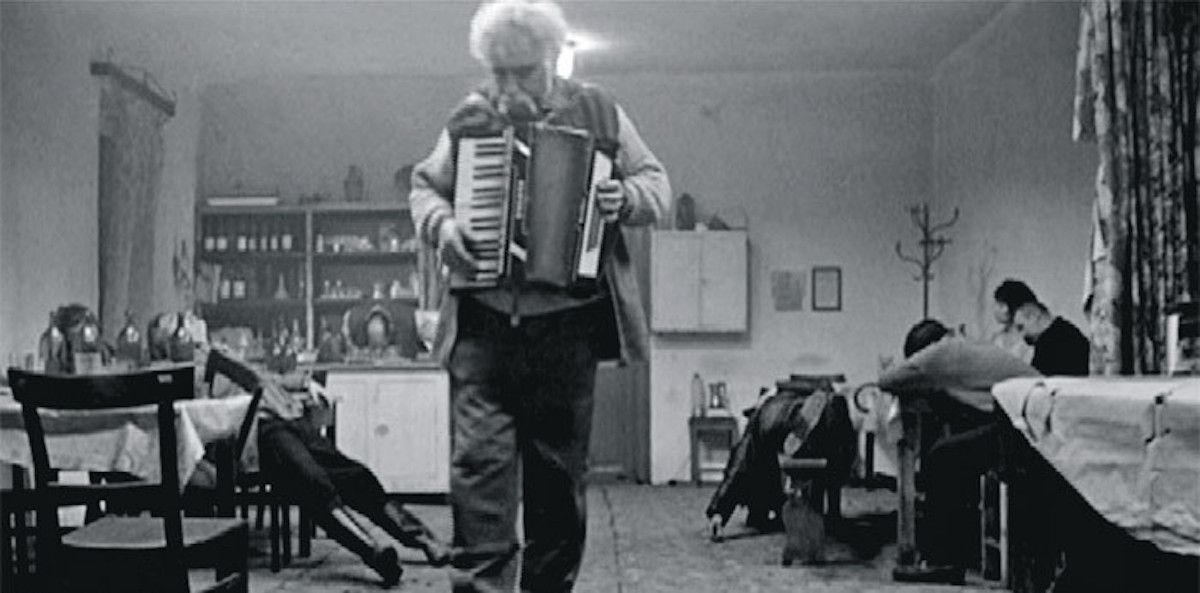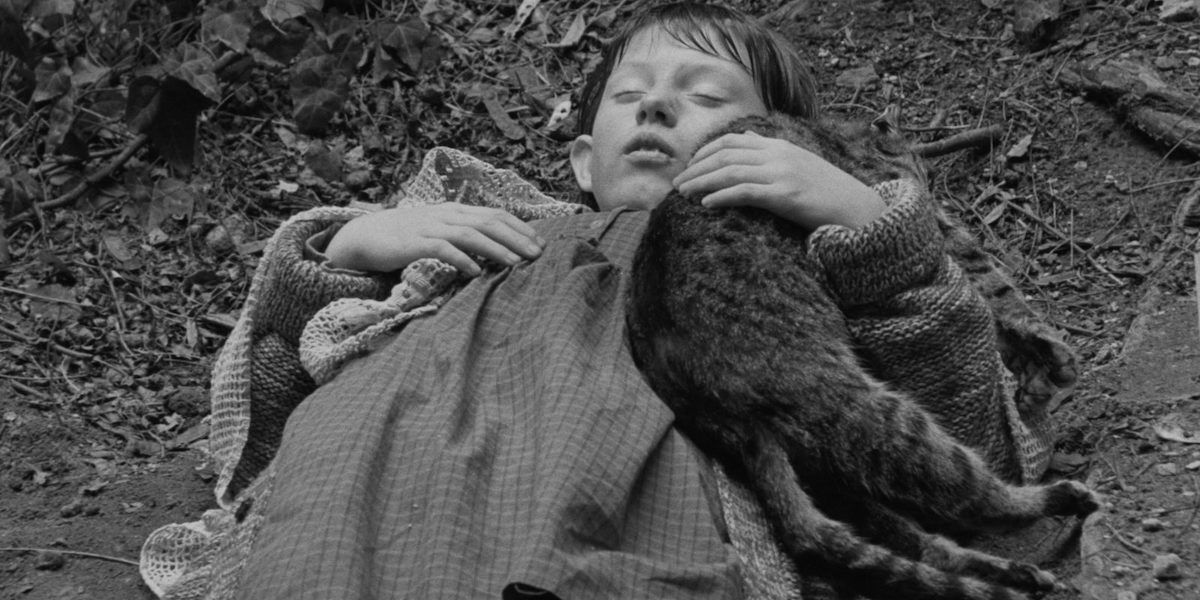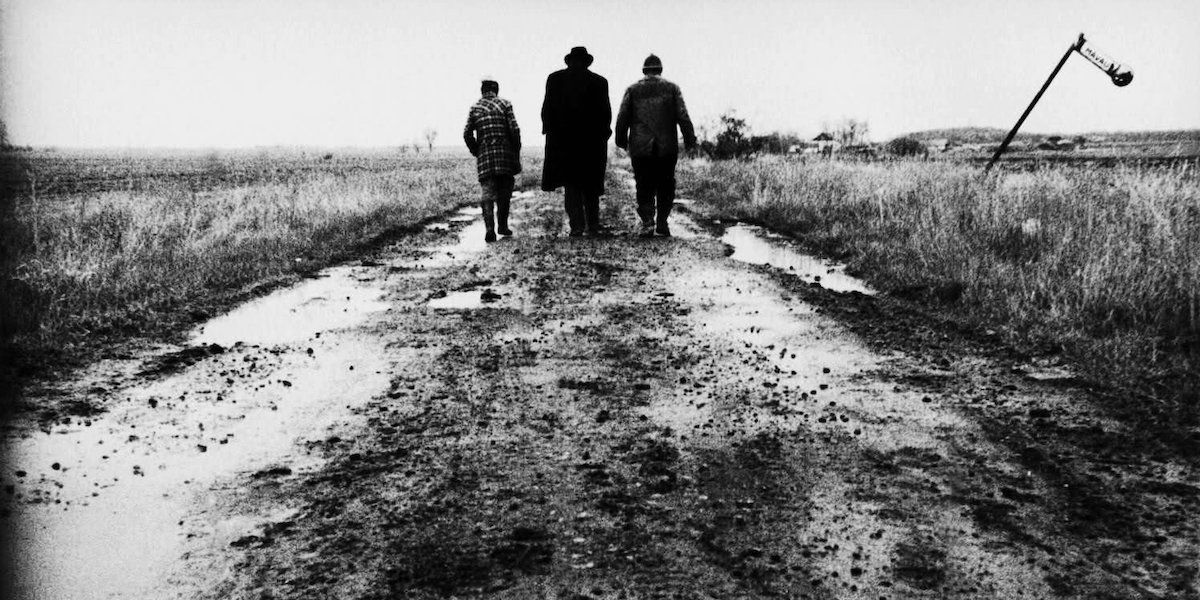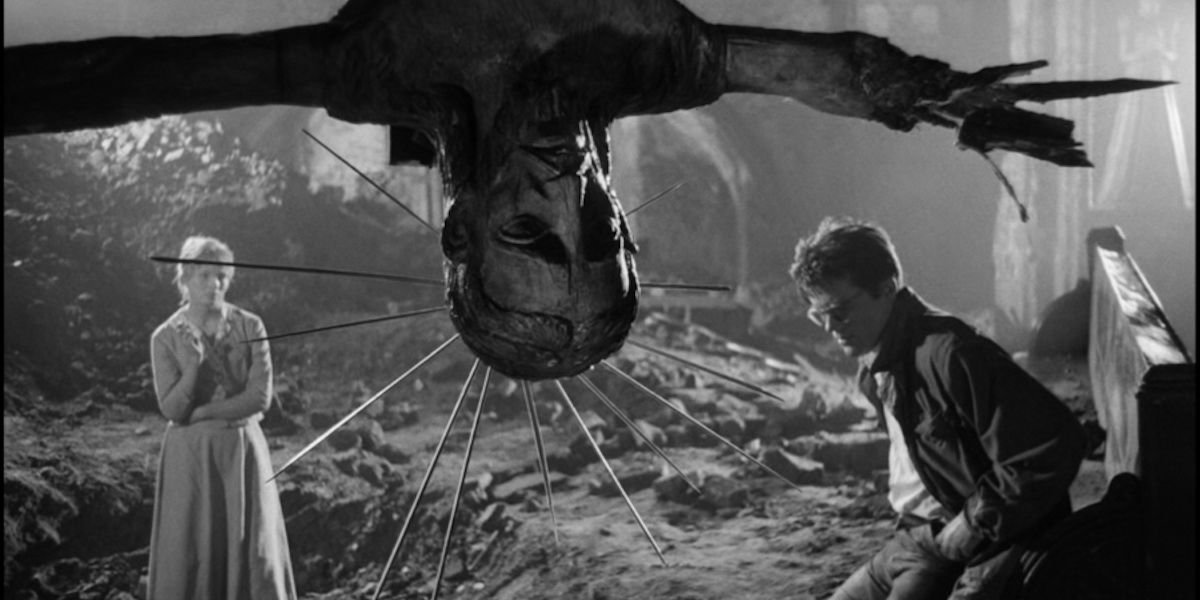After rising from a drunken fall, having finished the last of his fruit brandy, a doctor (Peter Berling) dresses up appropriately for the dreary, rainy weather and departs to make his way across a muddied road in the Hungarian countryside. He stumbles about slowly, almost glacially, stopping for moments as the rain patters upon his head. A single tracking shot follows the doctor on his long walk — it’s three full minutes, and in Sátántangó, Béla Tarr’s seven-plus hour epic, it’s a noticeably short shot by comparison to the others. That said, Sátántangó is a film requiring tremendous patience, with its gargantuan length far surpassing other lengthy films like Ryusuke Hamaguchi’s Happy Hour and Ingmar Bergman’s Fanny and Alexander. It’s a single movie only slightly shorter than the entire Lord of the Rings trilogy, only in Sátántangó, the film’s staggering length isn’t used to portray a sprawling, epic tale like Peter Jackson’s lauded films. Instead, Béla Tarr combines his film’s seven-and-a-half-hour runtime with an almost stagnant pace to express the futility and despair of his characters.
Based on a novel by László Krasznahorkai, Tarr’s film focuses on members of a collective farm in the Hungarian countryside as they remain financially shattered after the unexpected closing of their sole source of revenue. It’s a film that pushes to their limits the techniques frequently found in other works of slow cinema, a sort of sub-genre that’s exactly what it sounds like: films that move slowly, often with minimal plot points. In his book Transcendental Style In Film, critic/writer/director Paul Schrader writes about Soviet filmmaker Andrei Tarkovsky’s movies: “time was not a means to a goal. It was the goal”. The same can be said of Sátántangó, though its intention in capturing time is distinctly novel and vastly different from Tarkovsky’s. With the seven-plus hours of his epic film, Béla Tarr captures the futility and hopelessness of the villagers as they struggle against the indifferent waves of time. Sounds bleak, doesn’t it? Well, it is. Sátántangó is no afternoon picnic.
The movie’s staggering runtime is no gimmick; in fact, it’s essential to the film’s poetic meaning. This is a village filled with people whose attempt to escape their conditions is entirely futile. Time crushes them—it passes them by without a care for any of them. When they hope to improve their lives through investing in a new collective at the request of the enigmatic Irimiás (Mihály Vig), their fates, though undisclosed, are suggested to be unfavorable. It’s a film that moves remarkably slowly, with only one-hundred-and-fifty-ish shots taking up the film’s entirety. When the camera focuses on a character, it tends to linger on them for an extended period of time. Scenes of people sweeping up the backroom of a bar, walking, eating bread, listening to a bell’s toll, dancing, staring out into the void...all of these and so much more are featured in Sátántangó.
It’s through its unrelenting focus on the banal that Tarr’s film creates such an overwhelming state of helplessness. Many of Tarr’s shots are like moving still-life frames in which nothing remarkable is happening. Consequently, time is shown to move on and on as nothing occurs that saves the villagers from their unfortunate circumstances. Because the film is as long as it is, the time is felt rather than simply portrayed.
When an innkeeper (Zoltán Kamodi) learns of Irimiás’s unexpected return to town, he retreats to his backroom and throws a fit, breaking crates, and throwing things about. He’s skeptical, even suspicious of Irimiás. Slowly, though, he snaps out of it, takes a contemplative breather, and gets to work cleaning up the mess he made. It’s a painstaking act of cleaning up his own senseless mess, and Tarr’s camera stays focused on the entire ordeal. It doesn’t cut away or speed things up. It just stays there as the man succumbs to his fate. His sound and fury die down, and the absurd futility of his tantrum is made clear.
Much of the film works like this. Miserable people are stuck where they are. Because the film moves at an almost imperceptible pace, their stagnancy is made all the more apparent. Around them, their country is crumbling, their collective has failed, and their few opportunities for improvement are commandeered and exploited by opportunists. Irimiás, appearing from nowhere with suspicious promises of rescuing the community, never really does anything of value. The man has an almost messianic influence on the rest of the villagers. They follow him quite blindly at first, hoping he’ll rescue them from their despair. He doesn’t. While they wait, so, too does the film. Again, there are shots in which very little is occurring. There is little enough plot to condense Sátántangó down to a much shorter movie, but that would defeat the purpose.
When the doctor stumbles about, collapsing in a drunken stupor, then rising again before setting out into the rain, the camera shows his struggle in its entirety. It’s no easy feat for him to make it along the path, and the film makes sure to tell us this. The same can be said of the film’s numerous other scenes of travel. Any significant distance traveled is made all the more clear through the camera’s lingering. Because of how long the travelers are followed each time, it tends to feel like they aren’t going anywhere—or like they’ll never quite arrive where they mean to. “I was plodding and plodding and plodding along,” one of the villagers later drunkenly begins a tale. Plodding and plodding and plodding indeed. The film plods along without any release.
Perhaps the clearest example of the film’s tiring portrayal of futility can be found in the character of Estike (Erika Bók), a young mentally handicapped girl, who is largely ignored by the villagers. The fifth segment of the film, “Those Coming Unstitched”, follows Estike as she is conned by her older brother who convinces her to bury her savings in order to grow a money tree, only for the young man to return later and steal what she’d buried. In a brutal and disturbing scene, Estike poisons her cat—simply because she can, it would seem. It’s a wicked act of cruelty coming from an unexpected perpetrator. As the film continues at its glacial pace, Estike’s life is made all the more empty.
Even before the killing of her cat, Estike has little to do. Because of the film’s gargantuan length, it’s allowed to spend nearly an hour with the girl as very little happens. The emptiness of her life is made perfectly clear. She spends time in a barn, stares blankly at nothing, and walks down a rainy road. Later, she peeps on the other villagers that have collected in the inn, in one of the film’s most captivating and expressive sequences.
All of them are drunkenly dancing about (is this the titular Satan’s Tango?), while Estike secretly watches from outside the window of the inn. She is an outsider, literally and metaphorically, and no matter how long she looks on, she isn’t invited in. It’s a scene cut into two unbroken takes that run five minutes each. Splitting the two takes is a single, comparatively brief shot of the girl watching through the window. The villagers continue to dance, numbed by drink, into the night. It can be argued that there’s little else for them to do. They’re stuck in a financially doomed village in danger of starving.
Estike poisons herself shortly after this scene. After leaving the inn, she encounters the doctor and begs for him to help save her cat. He rebuffs her, focused on refilling his brandy. In an unbearable state of despair, the girl passes away. Taken as a whole, this segment is one of the most unpleasant forty minutes in cinema. In another film, these events could be condensed to ten minutes or less, but Sátántangó isn’t as much about the events as it is about the time it takes for such events to occur.
In a sense, Estike can be seen as a metaphor for the entirety of the villagers, and through Sátántangó’s nihilistic worldview, a metaphor for humankind itself. She is helpless, despairing, and she reaches out for help, only to be turned down by one of the few people that could actually help her. Tarr’s camera rarely cuts away from her as she descends into her chilling fate. It lingers, watching, as tragedy occurs. Nobody comes to prevent it, and through the particularly long takes, this fact is made all the more excruciating.
The fact that the villagers follow Irimiás towards his alleged promised land and never get there (since it doesn't actually exist) helps build the film's despairing view. After seven long, slow-burning hours, they aren't rescued. They remain stuck exactly as they were, penniless and without hope. By moving slowly and continuing for so long, Sátántangó lets the viewer share this experience to some degree. None of the characters' problems are ever really solved. Instead, viewers are made to wait for a release from these conditions. Expecting something to occur, for the film’s grammar to break, is futile. We’re only stuck there, much like the characters, with little hope of escaping. Sátántangó shows how its characters wait and wait (and wait) for their conditions to change, to no avail.
There’s no chance denying it: Sátántangó is a long film. It’s a really, really long film. While the length of Sátántangó (a good movie) often precedes the reputation of the film itself (often unjustly so), it isn’t too long of a film. Sure, it’s not a movie that would often be selected from somebody’s queue, but thanks to the ease with which anybody with reliable internet access can binge an entire season of their entire show in a single afternoon, Sátántangó’s intimidating length seems unconquerable than it may once have. It also helps that Sátántangó is broken up to 12 episodes that can be consumed individually. Tarr has expressed a wish for his viewers to digest the movie in a single sitting, save for a much-needed intermission between the film’s two halves. Still, a whole work day’s worth of cinema-viewing seems daunting. Should ambitious cinephiles choose to take Tarr’s challenge and watch the film all at once, however, they’d definitely be rewarded with an overwhelming artistic experience.
The American Cinematheque in California is playing Sátántangó for their ‘Cinema of Despair’ program, with two short intermissions separating the movie into three sections. Other theaters, like New York’s Lincoln Center and Madison’s UW Cinematheque have played Tarr’s film in a similar manner. Sátántangó is the type of film that is experienced more than it is viewed. It may sound cliché, even pretentious, but it’s true: Sátántangó is a sweeping, exhausting masterpiece that, like a colossal leviathan, swallows its viewers whole and refuses to let go. It’s unsettling and unrelentingly bleak, and in its extensive runtime it accomplishes so much by doing little. In a scene in the first half of the film, Futaki fantasizes about moving away to beginning a dull, idyllic life and “wathching fuckin’ life just pass by”. For almost eight hours, that’s essentially what happens: life passes them all by, leaving them in the dust with all their futility.





